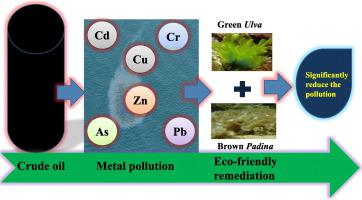Marine Pollution Bulletin ( IF 5.3 ) Pub Date : 2021-11-30 , DOI: 10.1016/j.marpolbul.2021.113156 Fuad Ameen 1 , Ali A Al-Homaidan 1 , Hanan Almahasheer 2 , Turki Dawoud 1 , Suaad Alwakeel 3 , Sama AlMaarofi 4

|
The transporting of oil via the Arabian Gulf for centuries has resulted in the pollution of the coasts by heavy metals, and therefore, remediation actions are needed. In this review, we first evaluated heavy metal pollution on the coasts by assembling the research on published metal concentrations in sediments and water bodies surrounding the Arabian Peninsula. Research revealed uneven pollution of heavy metals, meaning that before remediation, the most polluted sites should be found. This could be done most conveniently using biomonitoring. The Arabian Peninsula is a unique ecoregion due to the extremely high temperature in summer, and therefore, it needs its specific standardization procedure for biomonitoring. To get an overview of the current information on biomonitoring, we gathered a dataset of 306 published macroalgal observations from the Arabian Gulf and the Gulf of Aden. The heavy metal concentration dataset of macroalgae was analyzed with a multivariate principal component analysis. As a result of the published works elsewhere and our data analysis, we recommend that green Ulva and brown Padina species are used in the biomonitoring of heavy metal pollution on the Arabian Peninsula's eastern and southern coasts. However, more species might be needed if these species do not occur at the site. The species incidence should first be monitored systematically in each area, and common species should be used. The species used should be chosen locally and sampled at the same depth at low tide in spring or early summer, from February to May, before the hottest season. The composite samples of different apical sections of the thallus should be collected. The standardization of the monitoring processes benefits future remediation actions.
中文翻译:

使用大型藻类对阿拉伯湾和亚丁湾的沿海污染进行生物监测:综述
几个世纪以来,通过阿拉伯湾的石油运输导致沿海地区受到重金属污染,因此需要采取补救措施。在这篇综述中,我们首先通过汇总对阿拉伯半岛周围沉积物和水体中已发表的金属浓度的研究来评估沿海地区的重金属污染。研究表明重金属污染不均,这意味着在修复之前,应该找到污染最严重的地点。这可以使用生物监测最方便地完成。由于夏季气温极高,阿拉伯半岛是一个独特的生态区,因此需要其特定的生物监测标准化程序。要了解有关生物监测的当前信息,我们收集了来自阿拉伯湾和亚丁湾的 306 个已发表的大型藻类观测数据集。使用多元主成分分析对大型藻类的重金属浓度数据集进行了分析。由于在其他地方发表的作品和我们的数据分析,我们建议绿色石莼和棕色Padina物种被用于对阿拉伯半岛东部和南部海岸的重金属污染进行生物监测。但是,如果这些物种不在现场出现,则可能需要更多物种。应首先对各地区的物种发生率进行系统监测,并采用常见物种。使用的物种应在当地选择,并在春季或初夏的低潮时,即最热季节之前的二月至五月,在相同深度取样。应收集菌体不同顶端部分的复合样品。监测过程的标准化有利于未来的补救行动。











































 京公网安备 11010802027423号
京公网安备 11010802027423号